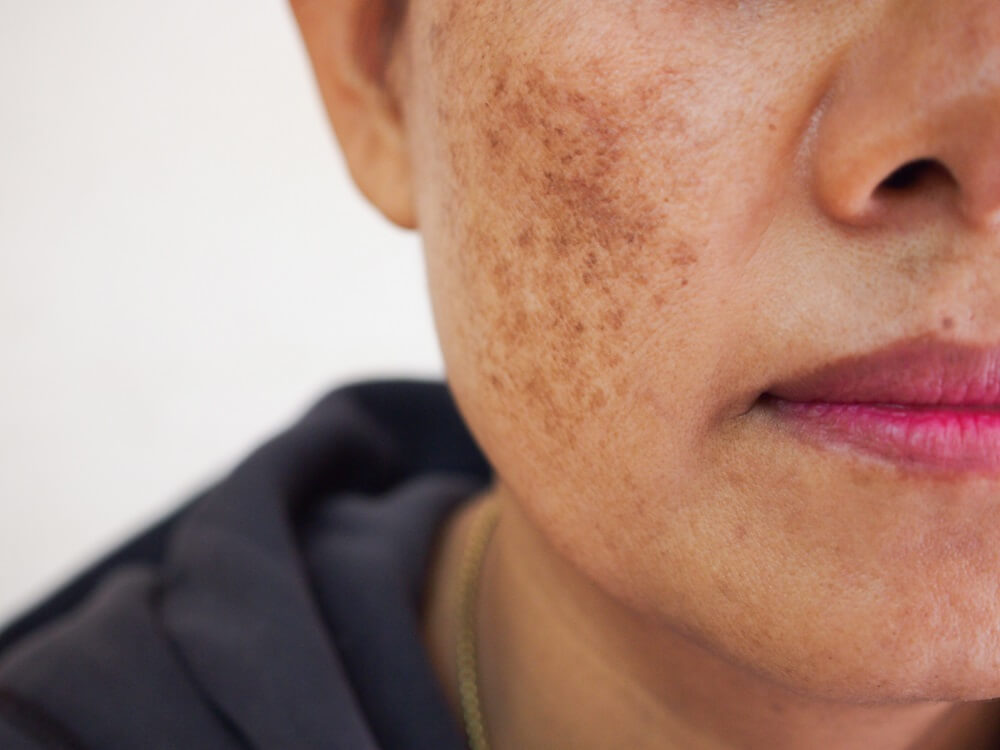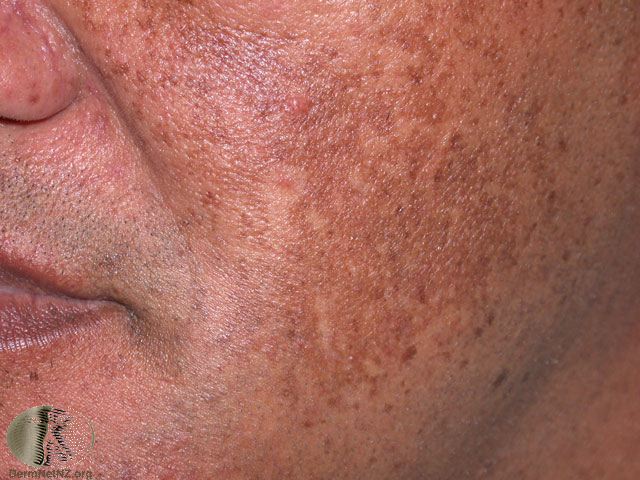Melasma Treatments from U.S. Dermatology Partners
What Is Melasma?
Melasma is a fairly common skin condition that creates the appearance of brown to gray-brown patches of skin, usually on the face. It can also occur on the neck and forearms and is the result of the body producing too much melanin, that natural substance that colors our hair, skin, and eyes.
If you’re dealing with dark spots or patches on your skin from the chronic condition melasma, the U.S. Dermatology Partners team can help you to improve the appearance of these spots and minimize the risk for future flare-ups of the condition. Read the page below to learn more or reach out to the U.S. Dermatology Partners location nearest you for more information.
Find This Service Near You
What Is Melasma?
Melasma is a fairly common skin condition that creates the appearance of brown to gray-brown patches of skin, usually on the face. While the development of melasma symptoms is most common on the face, the darker patches of skin can also occur on the neck, forearms, and other areas, especially those that receive the most sun exposure. Melasma occurs as a result of the body producing too much melanin, the natural substance which provides pigmentation to our hair, skin, and eyes.
Dermatologic researchers understand that melasma occurs due to an overproduction of melanin, but the reason this happens is not as clear. While dermatologists have not pinpointed one specific underlying cause of the excessive melanin production that occurs for those diagnosed with melasma, certain contributing factors may increase a person’s risk for developing the condition.

Melasma creates the appearance of grown to gray-brown patches on the skin.
Who Is at Risk for Melasma?
Although melasma can affect anyone, people with darker skin tones and people with a family history of melasma are more likely to get it. Women get melasma at a much higher rate than men, as only 10 percent of people diagnosed with it are male.
Additional risk factors connected with melasma diagnosis include:
- Pregnancy
- Use of contraceptive birth control pills
- Hormone therapy and other hormonal fluctuations
- Sun exposure
- Certain medications (including antiseizure medications)
- Use of some cosmetic products
What are the Symptoms of Melasma?

Melasma creates grown to gray-brown patches on the face. (Source)
Depending on the individual’s skin tone, the appearance of melasma may vary. The main symptoms associated with this condition are patches on the skin that are darker than your natural skin color. The patches most commonly appear on the cheeks, forehead, bridge of the nose, upper lip, and chin, but they may also appear on other parts of the body frequently exposed to sunlight, including the arms and neck. While melasma is usually easily recognized, it may be mistaken for some other common skin conditions, so in order to receive an accurate diagnosis, you need to schedule a consultation session with an experienced dermatologist. During this appointment, your dermatologist will verify if you are dealing with melasma and partner with you to create a treatment and maintenance care plan that fits your general skin care needs.
What are the Treatment Options for Melasma?
For some patients, melasma can fade on its own, particularly when the trigger is something temporary, like pregnancy or oral contraceptive use. Because melasma is not harmful, we may recommend not treating this condition at all. But, if the cosmetic appearance of melasma is a major concern, you can seek treatments that will improve the appearance of the darker spots that occur during melasma flareups.
Treatment options may include using topical lighteners that are available in both prescription and over-the-counter dosages. Specifically, we may recommend the use of topical hydroquinone.
Medical treatments can also be performed by your dermatologist at U.S. Dermatology Partners, including the following:
 Chemical Peels
Chemical Peels
As the name indicates, this treatment peels away the outer layers of skin where the dark spots are located. Chemical peels reveal a layer of new skin, resulting in improved evenness in tone and texture.
 Microneedling
Microneedling
This treatment uses tiny needles to create punctures in the skin’s outer layers. The body’s healing response is activated by these micro-injuries, eliminating the damaged tissues and replacing them with healthy, new skin cells. Typically, these new cells will be closer to the natural skin tone.
 Microdermabrasion
Microdermabrasion
In microdermabrasion, the surface layer of the skin is gently buffed away. Once again, this removed skin is replaced with healthy, new skin with a more even tone and texture.
 Laser Skin Lightening
Laser Skin Lightening
Laser skin lightening treatments can be particularly effective if you just want to reduce discoloration in a small area or on a few smaller spots. Laser therapy may also be recommended as a follow up for other melasma treatments like chemical peels, microneedling, and microdermabrasion.
Whatever treatment plan you develop with your dermatologist, it’s important for patients to understand that there is no such thing as an overnight cure for melasma. Any treatment option will take time to be effective, but if you commit to a treatment plan with your dermatologist and consistently follow this plan, you should see an improved appearance within a few weeks or months.
Can Melasma be Prevented?
Like most chronic skin conditions, you are likely to experience flare-ups in melasma symptoms throughout your life. However, by establishing an effective maintenance care plan in partnership with your dermatologist, you can significantly limit flare-ups in the condition and improve overall skin health. Each person’s needs will vary and a dermatologist can give you specific product recommendations and help you develop a personalized melasma flare-up prevention plan. Some basic steps that all individuals with melasma should take to minimize symptom flare-ups include:
Sun protection –
- The sun can trigger the production of melanocytes, which in turn can lead to the formation of new dark spots or enlarges existing dark spots related to melasma flareups. To prevent symptoms, minimize the appearance of existing dark spots, and maintain the results of melasma treatment, you need to apply an SPF 30 or higher sunscreen every day. If you’re planning to be outdoors for an extended time, make sure to reapply sunscreen regularly and take breaks from the sun periodically.
Create an effective daily care plan –
- Pollutants in the air, substances in water, and chemical exposure can trigger melasma flareups or increase the risk for a flareup. A good daily skincare routine will remove all foreign matter from the skin, limiting risk. Your dermatologist will recommend the best products for your skin type, but a gentle cleanser used at least twice a day is typically effective in minimizing the risk of a melasma flare-up.
Moisturize –
- The skin needs a good lipid (fat) barrier to prevent damage and avoid the unnecessary, excessive production of melanocyte cells, which darken the skin. Moisturizing is necessary to keep the skin’s protective lipid barrier in place. Use a good facial moisturizer at least twice each day, and apply a full-body moisturizer at least once each day.
Apply antioxidants –
- Oxidization is the chemical process that causes rust and wrinkles, so it’s no surprise that this damaging process is a contributing factor in melasma flareups. Using antioxidant serums can heal sun damage, maintain even skin tone, and help to prevent the development of dark spots.
Stay consistent –
- Melasma can be a frustrating condition to treat. Even the most advanced solutions take time to show improvement. There really is no instant fix for melasma. By maintaining a consistent prevention and care plan, you will see improvement in your condition over time.
Is Melasma Treatment Permanent?
Unfortunately, there is no cure for melasma. It is a chronic skin condition, and if you’ve been diagnosed with melasma, you’re likely to experience flare-ups throughout your life. By taking steps to prevent and minimize flare-ups like using sunblock daily, treating melasma with your dermatologist as soon as you notice severe symptoms, and maintaining an effective at-home maintenance care routine, you can significantly minimize the symptoms of melasma.
*Results may vary by individual

 Chemical Peels
Chemical Peels Microneedling
Microneedling Microdermabrasion
Microdermabrasion Laser Skin Lightening
Laser Skin Lightening